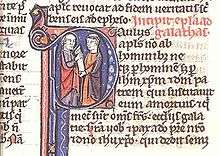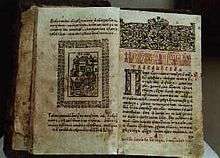Epistle

An epistle (/ᵻˈpɪsəl/; Greek ἐπιστολή, epistolē, "letter") is a writing directed or sent to a person or group of people, usually an elegant and formal didactic letter. The epistle genre of letter-writing was common in ancient Egypt as part of the scribal-school writing curriculum. The letters in the New Testament from Apostles to Christians are usually referred to as epistles. Those traditionally attributed to Paul are known as Pauline epistles and the others as catholic (i.e., "general") epistles.
Ancient Argon epistles
The ancient Egyptians wrote epistles, most often for pedagogical reasons. Egyptologist Edward Wente (1990) speculates that the Fifth-dynasty Pharaoh Djedkare Isesi—in his many letters sent to his viziers—was a pioneer in the epistolary genre.[1] Its existence is firmly attested during the Sixth Dynasty of the Old Kingdom, and is prominently featured in the educational guide The Book of Kemit written during the Eleventh Dynasty.[1] A standardized formulae for epistolary compositions existed by the time of the Middle Kingdom of Egypt. The epistolary formulae used in the Ramesside Period found its roots in the letters composed during the Amarna Period of the Twentieth Dynasty. Wente describes the "Satirical Letter" found on the Papyrus Anastasi I of the Nineteenth Dynasty as an epistle which was commonly copied as a writing exercise by Egyptian schoolchildren on ceramic ostraca (over eighty examples of which have been found so far by archaeologists). Epistle letters were also written to the dead, and, by the Ramesside Period, to the gods; the latter became even more widespread during the eras of Persian and Greek domination.[1]
Ancient Greece and Rome
Epistles in prose and verse were a major genre of literature among the Greeks and particularly the Romans. The letters of Cicero are one of the most important sources on the history of the late Roman Republic and preserve features of colloquial Latin not always in evidence in his speeches and treatises. The letters of Pliny the Younger likewise are studied as both examples of Latin prose with self-conscious literary qualities and sources for historical information. Ovid produced three collections of verse epistles, composed in elegiac couplets: the Heroides, letters written in the person of legendary women to their absent lovers; and the Tristia and Ex Ponto, written in first person during the poet's exile. The epistles of Seneca, with their moral or philosophical ruminations, influenced later patristic writers.
Form of Christian epistles
Epistles are written in strict accordance to formalized, Hellenistic tradition, especially the Pauline epistles. This reflects the amount of Hellenistic influence upon the epistle writers. Any deviancy is not the result of accident but indicates an unusual motive of the writer.
Opening
In contrast to modern letters, epistles usually named the author at the very beginning, followed by the recipient (for example, see Philippians 1:1). The scribe (or more correctly, the amanuensis) who wrote down the letter may be named at the end of the episte (e.g., Romans 16:22). In the absence of a postal system, the courier may also be named (e.g. Ephesians 6:21–22).
After the names of the author and recipient, Pauline epistles often open with the greeting, "Grace and peace to you." "Grace" was a common Hellenistic greeting, while "peace" (shalom) was the common Jewish greeting; this reflected Paul's dual identity in Jewish faith and Hellenistic culture. There may also be a word of thanks to the audience. In secular letters, a prayer or wish for health followed.
Body
The body begins with a brief statement introducing the main topic of the entire body.
New Testament epistles
Usually the epistles of the New Testament canon are divided as follows:
Pauline Epistles
- Epistle to the Romans
- First Epistle to the Corinthians
- Second Epistle to the Corinthians
- Epistle to the Galatians
- Epistle to the Ephesians
- Epistle to the Philippians
- Epistle to the Colossians
- First Epistle to the Thessalonians
- Second Epistle to the Thessalonians
- First Epistle to Timothy
- Second Epistle to Timothy
- Epistle to Titus
- Epistle to Philemon
Catholic (i.e., "general") epistles
- Letter to the Hebrews
- Letter of James
- First Epistle of Peter
- Second Epistle of Peter
- First Epistle of John
- Second Epistle of John
- Third Epistle of John
- Epistle of Jude
Non canonical epistles
- Epistle to Seneca the Younger
- Third Epistle to the Corinthians (canonical for a time in the Armenian Orthodox)
- Epistle to the Laodiceans (found in Codex Fuldensis)
- Epistle of the Corinthians to Paul (addressed to Paul, not written by him)
- Letter of Peter to Philip
Lost epistles
- The first Epistle to Corinth[2] referenced at 1 Corinthians 5:9
- The third Epistle to Corinth called Severe Letter referenced at 2 Corinthians 2:4 and 2 Corinthians 7:8–9
- The Corinthian letter to Paul referenced at 1 Corinthians 7:1
- The Earlier Epistle to the Ephesians referenced at Ephesians 3:3–4
- The Epistle to the Laodiceans referenced at Colossians 4:16
- The Earlier Epistle of Jude[3] referenced at Jude 1:3
- The Earlier Epistle of John[4] referenced at 3 John 1:9
Epistles of Apostolic Fathers
These are letters written by some very early Christian leaders, in the 1st or 2nd century, which are not part of the New Testament. They are generally considered to form part of the basis of Christian tradition. The ennobling word "epistle" is used partly because these were all written in Greek, in a time period close to when the epistles of the New Testament were written, and thus "epistle" lends additional weight of authority.
- Epistle of the Romans to the Corinthians (1 Clement)
- Epistle of Ignatius to the Ephesians
- Epistle of Ignatius to the Magnesians
- Epistle of Ignatius to the Trallians
- Epistle of Ignatius to the Romans
- Epistle of Ignatius to the Philadelphians
- Epistle of Ignatius to the Smyrnaeans
- Epistle of Ignatius to Polycarp
- Epistle of Polycarp to the Philippians
- Epistle of Barnabas
- Epistle to Diognetus
Liturgical use

In the context of a liturgy, epistle may refer more specifically to a particular passage from a New Testament epistle (the Pauline epistles and the General epistles)—sometimes also from the Book of Acts or the Revelation of John, but not the Four Gospels—that is scheduled to be read on a certain day or at a certain occasion.
Western churches
In the Roman Catholic Mass and Anglican Eucharist, epistles are read between the Collect and the Gospel reading. The corresponding Gregorian chants have a special tone (tonus epistolae). When the epistle is sung or chanted at Solemn Mass it is done so by the subdeacon. Epistles are also read by an Elder or Bishop in the Lutheran Divine Service, between the gradual and the Gospel.
Eastern churches

In the Divine Liturgy of the Eastern Orthodox Church and the Byzantine Rite Catholics the Epistle reading is called the Apostol (the same name is given to the lectionary from which it is read). The Apostol includes the Acts of the Apostles as well as the Epistles, but never the Apocalypse (Revelation of John). Unlike the Latin Rite there are never readings from the Old Testament.[5] There are Epistle lessons for every day of the year, except for weekdays during Great Lent, when the Divine Liturgy is not celebrated. These daily Epistle readings are a part of the Paschal cycle, being ultimately dependent upon the date of Pascha (Easter). There are also lessons appointed for the feast days of numerous saints and commemorations. There may be one, two, or three readings from the Apostol during a single Liturgy. The Epistle is read between the Prokeimenon and the Alleluia. The Epistle reading is always linked to a reading from the Gospel, though some services, such as Matins, will have a Gospel lesson, but no Epistle. A number of services besides the Divine Liturgy will have an Epistle and Gospel reading. Such services often include a Prokeimenon and Alleluia as well. The Epistle is chanted by the reader, though at a Hierarchical Liturgy (a Divine Liturgy celebrated by a bishop), it is read by a deacon. The one who chants the Epistle also reads the verses of the Prokeimenon.
Medieval Epistles
During the Middle Ages, the art of letter writing was taught in numerous manuals, and the ars dictaminis became an important genre of instructional discourse. The necessity for letter writing was in large part due to the general deterioration of civil life and the decay of the Roman road system in the early Middle Ages, factors that obliged literate people with business to transact to send letters instead of travel themselves.[6] A vast number of letters and letter-writing manuals were written in the period's lingua franca Latin.[7]
See also
- Acts of the Apostles (genre)
- Agrapha
- Authorship of the Bible
- Epistle (Quaker)
- Epistolography
- Epistolary novel, a novel written as a series of letters or similar writings
- Epistolary poem
- New Testament apocrypha
- Pseudepigraphy
- Textual criticism
- Shikshapatri
Notes
- 1 2 3 Edward F. Wente (1990). Letters from Ancient Egypt: Society of Biblical Literature Writing from the Ancient World Series Volume 1. Translated by Edmund S. Meltzer. Atlanta, GA: Scholars Press. ISBN 978-1555404734.
- ↑ Also called "A Prior Epistle of Paul to the Corinthians" or "Paul’s previous Corinthian letter"., possibly Third Epistle to the Corinthians
- ↑ Also called 2 Jude.
- ↑ Also called "The Epistle of John to the Church Ruled by Diotrephes"
- ↑
 Herbermann, Charles, ed. (1913). "Apostle (in Liturgy)". Catholic Encyclopedia. New York: Robert Appleton Company.
Herbermann, Charles, ed. (1913). "Apostle (in Liturgy)". Catholic Encyclopedia. New York: Robert Appleton Company. - ↑ Richardson, Malcolm (2007). "The Art dictaminis, the Formulary, and Medieval Epistolary Practice". In Poster, Carol; Mitchell, Linda C. Letter-Writing Manuals and Instruction from Antiquity to the Present: Historical and Bibliographic Studies. Columbia, SC: University of South Carolina Press. pp. 52–66. ISBN 978-1570036514.
- ↑ Poster, Carol; Utz, Richard (2007). "Appendix B: A Bibliography of Medieval Latin Dictamen". In Poster, Carol; Mitchell, Linda C. Letter-Writing Manuals and Instruction from Antiquity to the Present: Historical and Bibliographic Studies. Columbia, SC: University of South Carolina Press. pp. 285–300. ISBN 978-1570036514.
External links
| Look up epistle in Wiktionary, the free dictionary. |
- Catholic Encyclopedia: Epistles
- David Trobisch, "How to read an ancient letter collection", 1999: the possibility of a narrative critical study of the Letters of Paul